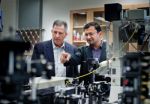(Press-News.org) Coral reefs are home to a rich and diverse ecosystem, providing a habitat for a wide range of marine animals. But the increasing acidification of ocean water is jeopardizing the calcified foundations of these reefs, endangering the survival of thousands upon thousands of resident species.
New research by Prof. Yehuda Benayahu, Dr. Zehava Barkay, Prof. Maoz Fine, and their jointly supervised graduate student Yasmin Gabay of Tel Aviv University's Department of Zoology, Wolfson Applied Materials Research Center and the Interuniversity Institute for Marine Sciences in Eilat has uncovered the protective properties of soft coral tissue, which proved resilient when exposed to declining oceanic pH levels. The study, published in PLOS One, provides insight into the changing face of coral reefs threatened by dropping oceanic pH levels and may provide a new approach toward preserving the harder, calcified reef foundations.
Reefs and environmental change
Acidification is caused by increased carbon dioxide emissions in the atmosphere due to global change, fossil fuel burning, and other pollution. These emissions dissolve in the ocean, resulting in a slight lowering of oceanic pH levels. This produces changes to ocean water's carbon content, destroying the calcification of reef-building stony coral.
"The rise in temperature and ocean acidification are the main concerns of environmental change," said Prof. Benayahu, the Israel Cohen Chair in Environmental Zoology, whose TAU laboratory is home to one of the world's only soft coral (octocoral) research centers. "We know the value of reefs, the massive calcium carbonate constructions that act as wave breakers, and protect against floods, erosion, hurricanes, and typhoons. While alive, they provide habitats for thousands of living organisms, from sea urchins to clams, algae to fish. Reefs are also economically important in regions like Eilat or the Caribbean."
At first, the researchers examined the effects of lowered pH levels on living colonies of soft corals. Observing no significant effects on their physiology, Gabay thought it would be interesting to consider the effects of acidification on the skeleton of these soft corals.
"We really wanted to know if something could survive dropping pH levels in the future," said Gabay. "I was curious as to whether coral tissue could protect the inner coral skeleton, which is of most use in terms of reef construction, so I conducted an experiment using live soft corals and soft coral skeletons, which were placed in tanks containing ocean water with manipulated pH levels."
Using state-of-the-art microscopy, Gabay then scanned the tissue-covered skeletons and bare skeletons of soft corals exposed to experimental acidic conditions, the same conditions the International Panel of Climate Change predicts will occur 100 years from now if CO2 emissions continue to rise. She found that the bare soft coral skeletons exhibited acidic stressed symptoms – large pockets burned into their microscopic corpuscular subunits – whereas the tissue-covered skeleton revealed almost no damage to its microscopic subunits.
"We found that the soft coral's tissue may indeed protect the skeleton from declining pH levels," said Yasmin Gabay. "The organism's internal environment apparently has a mechanism that protects against the acidic conditions."
The future of "the orchestra"
According to Prof. Benayahu, the future of soft-coral reefs is still unclear. Soft corals are not primary reef builders, because their skeletons are slow to calcify. Stony corals provide the massive skeletons that create reefs. Soft corals are replacing these reef builders, because they are somehow able to survive and live under extreme environmental conditions.
"A reef is like an orchestra. Many organisms interact to create harmony," said Prof. Benayahu. "Thousands of species live together and create life together. It is hard to predict what will happen if only soft corals survive, because they simply do not calcify at same rate as stony corals."
The researchers are currently studying the potential effects of soft coral displacement of stony coral species and the subsequent ramifications for reefs.
INFORMATION:
American Friends of Tel Aviv University supports Israel's leading, most comprehensive and most sought-after center of higher learning, Tel Aviv University (TAU). Rooted in a pan-disciplinary approach to education, TAU is internationally recognized for the scope and groundbreaking nature of its research and scholarship — attracting world-class faculty and consistently producing cutting-edge work with profound implications for the future. TAU is independently ranked 116th among the world's top universities and #1 in Israel. It joins a handful of elite international universities that rank among the best producers of successful startups.
Can coral save our oceans?
Tel Aviv University researchers discover soft coral tissue may help protect reefs
2014-06-24
ELSE PRESS RELEASES FROM THIS DATE:
UT Arlington nanoparticles could provide easier route for cell therapy
2014-06-24
UT Arlington physics researchers may have developed a way to use laser technology to deliver drug and gene therapy at the cellular level without damaging surrounding tissue. The method eventually could help patients suffering from genetic conditions, cancers and neurological diseases.
In a study published recently by the journal Nature Scientific Reports, the team paired crystalline magnetic carbon nanoparticles and continuous wave near-infrared laser beams for in what is called photothermal delivery. Authors of the new paper are Ali Koymen, a professor of physics; Samarendra ...
How to protect an American wildlife legacy
2014-06-24
A new paper shows that while science plays a critical role in informing conservation action, scientists must move beyond the realm of their expertise into less familiar areas like public relations, education, and even politics, to ultimately meet America's conservation goals.
The paper, "Moving Beyond Science to Protect a Mammalian Migration Corridor," appears in the current online edition on the journal Conservation Biology, and will appear in Volume 28 of the print edition. Authors are Joel Berger of the Wildlife Conservation Society (WCS) and the University of Montana, ...
Group recommends removing sexual orientation-related disorders from the ICD
2014-06-24
A working group evaluating sexual orientation-related disorders listed in the International Classification of Diseases (ICD), a publication of the World Health Organization (WHO), has recommended the disorders be deleted, a move that will make getting health care easier for gays and others who may have gender atypicality.
The WHO is the world body charged with deciding what is a disease and more than 170 countries, including the United States, follow their recommendations. The organization is currently revising the 10th edition of the ICD for release of the 11th edition ...
UMMS scientists show that monarch butterflies employ a magnetic compass during migration
2014-06-24
WORCESTER, MA – Each fall millions of monarch butterflies use a sophisticated navigation system to transverse 2,000 miles from breeding sites across the eastern United States to an overwintering habitat in specific groves of fir trees in central Mexico. Scientists at the University of Massachusetts Medical School and Worcester Polytechnic Institute have identified a new component of this complex system. They reported in Nature Communications that monarchs use a light-dependent, inclination magnetic compass to help them orient southward during migration.
"Taken as a whole, ...
Cancer risks increase with complex heart tests
2014-06-24
Complex heart imaging can increase cancer risks for children throughout their lifetime, according to a new study co-authored by Le Bonheur Cardiologist Jason Johnson, MD, MHS. The study, which appears in the June 9, 2014 issue of the American Heart Association's journal Circulation, is the first in which researchers quantified cumulative radiation doses in pediatric heart patients and predicted lifetime cancer risks based on the types of exposures.
In the study, Johnson and fellow researchers found that radiation from standard X-rays don't significantly raise cancer risks ...
Those with episodic amnesia are not 'stuck in time,' says philosopher Carl Craver
2014-06-24
In 1981, a motorcycle accident left Toronto native Kent Cochrane with severe brain damage and dramatically impaired episodic memory. Following the accident, Cochrane could no longer remember events from his past. Nor could he predict specific events that might happen in the future.
When neuroscientist Endel Tulving, PhD, asked him to describe what he would do tomorrow, Cochrane could not answer and described his state of mind as "blank."
Psychologists and neuroscientists came to know Cochrane, who passed away earlier this year, simply as "KC." Many scientists have described ...
Mining mountains of data for medical insights
2014-06-24
Epidemiologists know that an important piece of evidence is often staring you in the face – but it's not always easy to see the forest for the trees.
Danish scientists recently teamed up with University of New Mexico researchers to test a powerful new method for predicting the progress of common diseases through time by teasing out previously undetected patterns from a very large data set – in this case, the health records of Denmark's entire population.
This approach maps out surprising correlations: a disease like gout – a form of arthritis – is strongly linked to ...
Research explains action of drug that may slow aging, related disease
2014-06-24
Dietary restriction is one of the most-researched methods for slowing the aging process. Now, a new article published in The Journals of Gerontology, Series A: Biological Sciences and Medical Sciences helps explain the action of a drug that appears to mimic that method — rapamycin.
Rapamycin, an antibiotic and immunosuppressant approved for use about 15 years ago, has drawn extensive interest for its apparent ability — at least in laboratory animal tests — to emulate the ability of dietary restriction in helping animals to live both longer and healthier.
However, this ...
Hormones affect voting behavior, Nebraska researchers find
2014-06-24
OMAHA, Neb. – Researchers from the University of Nebraska at Omaha (UNO), the University of Nebraska-Lincoln (UNL) and Rice University have released a study that shows hormone levels can affect voter turnout.
As witnessed by recent voter turnout in primary elections, participation in U.S. national elections is low, relative to other western democracies. In fact, voter turnout in biennial national elections ranges includes only 40 to 60 percent of eligible voters.
The study, published June 22 in Physiology and Behavior, reports that while participation in electoral ...
A collaboration of minds and metal
2014-06-24
This past January, Derek Ahneman, a graduate student in the lab of Abigail Doyle, a Princeton University associate professor of chemistry, began work on an ambitious new project: he proposed the merger of two areas of research to enable a powerful reaction that neither could broadly achieve on its own.
One field, which is the Doyle research group's domain, was nickel catalysis, wherein nickel squeezes in and out of chemical bonds to bring molecules together. The other field was photoredox catalysis, which uses light to initiate a series of unique bond-breaking and bond-making ...
LAST 30 PRESS RELEASES:
How do childcare tax credits affect children’s long-term health?
Can an electronic nose detect indoor mold?
Do natural disasters have long-term impacts on mortality in older adults?
Modification improves sodium‐ion batteries as an alternative to lithium-ion batteries
Parasports provide a range of benefits for people with cerebral palsy
How does grandparental care affect children’s health?
Why are there so many Nordic mediators?
Young shark species more vulnerable to extinction
Mobile fetal heart monitoring linked to fewer newborn deaths in Tanzania
Bluey’s dad offered professorial chair in archaeology at Griffith University
Beyond small data limitations: Transfer learning-enabled framework for predicting mechanical properties of aluminum matrix composites
Unveiling non-thermal catalytic origin of direct current-promoted catalysis for energy-efficient transformation of greenhouse gases to valuable chemicals
Chronic breathlessness emerging as a hidden strain on hospitals
Paleontologists find first fossil bee nests made inside fossil bones
These fossils were the perfect home for ancient baby bees
Not everyone reads the room the same. A new study examines why.
New research identifies linked energy, immune and vascular changes in ME/CFS
Concurrent frailty + depression likely boost dementia risk in older people
Living in substandard housing linked to kids’ missed schooling and poor grades
Little awareness of medical + psychological complexities of steroid cream withdrawal
Eight in 10 trusts caring for emergency department patients in corridors, finds BMJ investigation
NASA’s Webb telescope finds bizarre atmosphere on a lemon-shaped exoplanet
The gut bacteria that put the brakes on weight gain in mice
Exploring how patients feel about AI transcription
Category ‘6’ tropical cyclone hot spots are growing
Video: Drivers struggle to multitask when using dashboard touch screens, study finds
SLU research shows surge in alcohol-related liver disease driving ‘deaths of despair’
Rising heat reshapes how microbes break down microplastics, new review finds
Roots reveal a hidden carbon pathway in maize plants
Membrane magic: FAMU-FSU researchers repurpose fuel cells membranes for new applications
[Press-News.org] Can coral save our oceans?Tel Aviv University researchers discover soft coral tissue may help protect reefs



